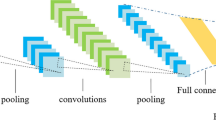Abstract
The artificial intelligence and, in particular, the artificial neural networks proved to be useful tools in the field of computer vision, with promising results of applications in various domains, such as: industry, agriculture, medicine, transport, and environment. Detecting and locating crops using images received from aerial robots can make a positive contribution to assessing possible damage, reducing losses and minimizing analysis time. The paper proposed different implementation of the conditional generative adversarial network to better accomplish the task of semantic segmentation the agricultural region of interest. To this end the images were acquired by unmanned aerial vehicles. The network consists of a generator built using the U-Net architecture model and a discriminator that provides a probability matrix for each prediction, the elements of the matrix corresponding to portions of the input image. The resulting model, implemented with GPU processors provided by Google, performs a binary segmentation of images to determine the areas containing crops. The results of five experiments obtained, in the best configuration of hyper-parameters tested, an average accuracy of 97.93% in relation to reference (manual) segmentation.
Access this chapter
Tax calculation will be finalised at checkout
Purchases are for personal use only
Similar content being viewed by others
References
Sharma, P.: Computer Vision Tutorial: A Step-by-Step Introduction to Image Segmentation Techniques (Part 1). https://www.analyticsvidhya.com/blog/2019/04/introduction-image-segmentation-techniques-python (2019). Accessed June 2020
Krizhevsky, A., Sutskever, I., Hinton, G.E.: ImageNet classification with deep convolutional neural networks. Commun. ACM 60, 84–90 (2017)
Lazo, J.F.: Detection of archaeological sites from aerial imagery using deep learning, FYTM03 20182 (2019)
Papandreou, G., Chen, L., Murphy, K., Yuille, A.L.: Weakly- and semi-supervised learning of a deep convolutional network for semantic image segmentation. arXiv:1502.02734v3 (2015)
Everingham, M., Eslami, S.M.A., Van Gool, L.: The PASCAL visual object classes challenge: a retrospective. Int. J. Comput. Vis. 98–136 (2015)
Mwiti, D.: A 2019 Guide to Semantic Segmentation. https://heartbeat.fritz.ai/a-2019-guide-to-semantic-segmentation-ca8242f5a7fc (2019). Accessed May 2020
Koltun, V., Krahenbuhl, P.: Efficient inference in fully connected CRFs with gaussian edge potentials. arXiv:1210.5644v1 (2012)
Li, C., Wand, M.: Precomputed real-time texture synthesis with markovian generative adversarial networks. In: Leibe, B., Matas, J., Sebe, N., Welling, M. (eds.) ECCV 2016. LNCS, vol. 9907, pp. 702–716. Springer, Cham (2016). https://doi.org/10.1007/978-3-319-46487-9_43
Pan, X., et al.: Building extraction from high-resolution aerial imagery using a generative adversarial network with spatial and channel attention mechanisms. Remote Sens. 11, 917 (2019)
Long, J., Shelhamer, E., Darrell, T.: Fully convolutional networks for semantic segmentation. arXiv:1411.4038v2 (2015)
Luc, P., Couprie, C., Chintala, S.: Semantic segmentation using adversarial networks. arXiv:1611.08408v1 (2016)
Xue, Y., Xu, T., Zhang, H., Long, L.R., Huang, X.: SegAN: adversarial network with multi-scale L_1 loss for medical image segmentation. arXiv:1706.01805v2 (2017)
Goodfellow, I., et al.: Generative adversarial nets. In: 27th International Conference on Neural Information Processing Systems (NIPS), vol. 2, pp. 2672–2680. Montreal, QC, Canada (2014)
Yoo, D., Kim, N., Park, S., Paek, A.S., Kweon, I.S.: Pixel-level domain transfer. In: Leibe, B., Matas, J., Sebe, N., Welling, M. (eds.) ECCV 2016. LNCS, vol. 9912, pp. 517–532. Springer, Cham (2016). https://doi.org/10.1007/978-3-319-46484-8_31
Karacan, L., Akata, Z., Erdem, A., Erdem, E.: Learning to generate images of outdoor scenes from attributes and semantic layouts, arXiv:1612.00215v1 (2016)
Ronneberger, O., Fischer, P., Brox, T.: U-Net: convolutional networks for biomedical image segmentation. In: Navab, N., Hornegger, J., Wells, W.M., Frangi, A.F. (eds.) MICCAI 2015. LNCS, vol. 9351, pp. 234–241. Springer, Cham (2015). https://doi.org/10.1007/978-3-319-24574-4_28
Isola, P., Zhu, J.Y., Zhou, T.H., Efros, A.A.: Image-to-image translation with conditional adversarial networks. In: IEEE Conference on Computer Vision and Pattern Recognition, pp. 5967–5976. Honolulu, Hawaii, July 22–25 (2017)
Damien, A.: Generative Adversarial Network Example. https://wizardforcel.gitbooks.io/tensorflow-examples-aymericdamien/3.11_gan.html. Accessed June 2020
Vrejoiu, M.H.: Convolutional neural networks, big data and deep learning in automatic image analysis (Reţele neuronale convoluţionale, Big Data şi Deep Learning în analiza automată de imagini). Roman. J. Inf. Technol. Automat. Control 29, 91–114 (2019)
Popescu, D., Ichim, L., Stoican, F.: Flooded area segmentation from UAV images based on generative adversarial networks. In: 15th International Conference on Control, Automation, Robotics and Vision (ICARCV 2018), pp. 1361–1366. Singapore, November 18–21 (2018)
Vemuri, P.V.N.: Image Segmentation with Python. https://kite.com/blog/python/image-segmentation-tutorial (2019). Accessed June 2020
Tiu, E.: Metrics to Evaluate your Semantic Segmentation Model. https://towardsdatascience.com/metrics-to-evaluate-your-semantic-segmentation-model-6bcb99639aa2 (2019). Accessed June 2020
Python. https://www.python.org. Accessed June 2020
NumPy. https://numpy.org. Accessed May 2020
Scikit-image. https://scikit-image.org. Accessed May 2020
Matplotlib. https://matplotlib.org. Accessed May 2020
Sharma, H.: Activation Functions: Sigmoid, ReLU, Leaky ReLU and Softmax Basics for Neural Networks and Deep Learning. https://medium.com/@himanshuxd/activation-functions-sigmoid-relu-leaky-relu-and-softmax-basics-for-neural-networks-and-deep-8d9c70eed91e (2019). Accessed June 2020
Tanh. http://pytorch.org/docs/master/generated/torch.nn.Tanh.html. Accessed June 2020
Google Colab. https://colab.research.google.com. Accessed June 2020
Google Drive. https://drive.google.com. Accessed June 2020
GitHub. https://github.com. Accessed June 2020
Soria, X., Riba, E., Sappa, A.: Dense Extreme Inception Network: Towards a Robust CNN Model for Edge Detection. arXiv:1909.01955v2 (2020)
Acknowledgements
This work was supported by a grant of the Ministry of Research, Innovation and Digitization, CNCS/CCCDI – UEFISCDI, project number 202/2020, within PNCDI III.
Author information
Authors and Affiliations
Corresponding author
Editor information
Editors and Affiliations
Rights and permissions
Copyright information
© 2021 Springer Nature Switzerland AG
About this paper
Cite this paper
Popescu, D., Ichim, L., Sava, O.A. (2021). Semantic Segmentation of Small Region of Interest for Agricultural Research Applications. In: Nguyen, N.T., Iliadis, L., Maglogiannis, I., Trawiński, B. (eds) Computational Collective Intelligence. ICCCI 2021. Lecture Notes in Computer Science(), vol 12876. Springer, Cham. https://doi.org/10.1007/978-3-030-88081-1_44
Download citation
DOI: https://doi.org/10.1007/978-3-030-88081-1_44
Published:
Publisher Name: Springer, Cham
Print ISBN: 978-3-030-88080-4
Online ISBN: 978-3-030-88081-1
eBook Packages: Computer ScienceComputer Science (R0)




